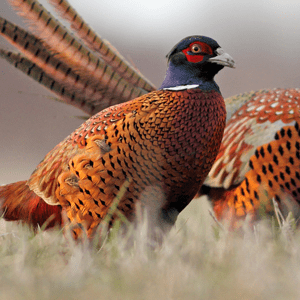Fall is particularly significant for pheasant survival during their lifecycle.
During this transitional time, young pheasants are maturing, food sources are shifting, and habitat demands intensify. Understanding their ecological needs during this window provides valuable insight for both conservation and management efforts.
In late summer, southern Alberta’s pheasants rely heavily on a mosaic of habitats that provide cover, food, and shelter from predators. Roadside ditches, riparian corridors, shelterbelts, and unmanaged grassy fields serve as critical refuge. Agricultural landscapes dominate the region, and pheasants are especially tied to grain fields, stubble, and haylands that provide both food and concealment.
When cover is scarce, pheasants will tend to concentrate in undisturbed areas such as cattail sloughs, brushy draws, and perennial cover areas. The patchwork nature of southern Alberta’s farmland makes the availability of these secure habitats a key factor in late-season survival.
The dietary needs of ring-necked pheasants shift into fall, giving this period of a pheasants lifecyle its ‘foraging’ moniker. Young pheasants, hatched in early to mid-summer, rely on protein-rich insects during their first weeks of life. By late summer, they transition toward a more adult diet, composed of seeds and grains. Cereal grains such as wheat, barley, and oats become staple foods. Seeds from weeds and native forbs also contribute to their nutrition.
As harvest progresses, grain left behind by combines becomes a crucial resource. The stubble fields and spilled kernels scattered across farmland provide easily accessible calories that help birds build fat reserves for the harsher months ahead. Insects remain a minor but still valuable dietary component during warm spells. Access to a diverse food base during this period is essential for ensuring both juvenile survival and adult conditioning before winter.
Despite autumn’s abundance of food, pheasants face significant survival challenges. First and foremost is habitat loss during harvest. As crops are removed, pheasants lose concealment, forcing birds to travel greater distances across exposed ground, heightening their vulnerability to predators such as coyotes, hawks, and owls.
Sudden early frosts or storms can reduce insect availability and damage vegetative cover. Birds must find reliable roosting areas that offer thermal protection. Without these safe havens, pheasants risk higher mortality as temperatures decline.
Habitat diversity, abundant food resources, and secure cover determines whether young birds are adequately prepared for winter.
Conservation efforts by Pheasants Forever play a major role in providing habitat for this vital period of the life cycle.



